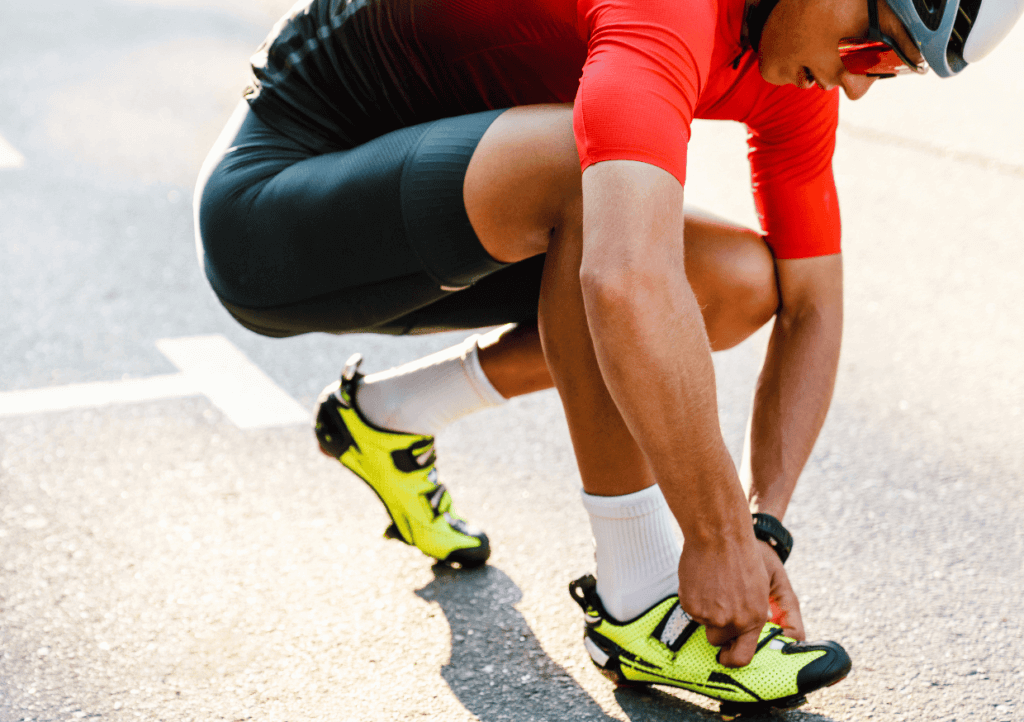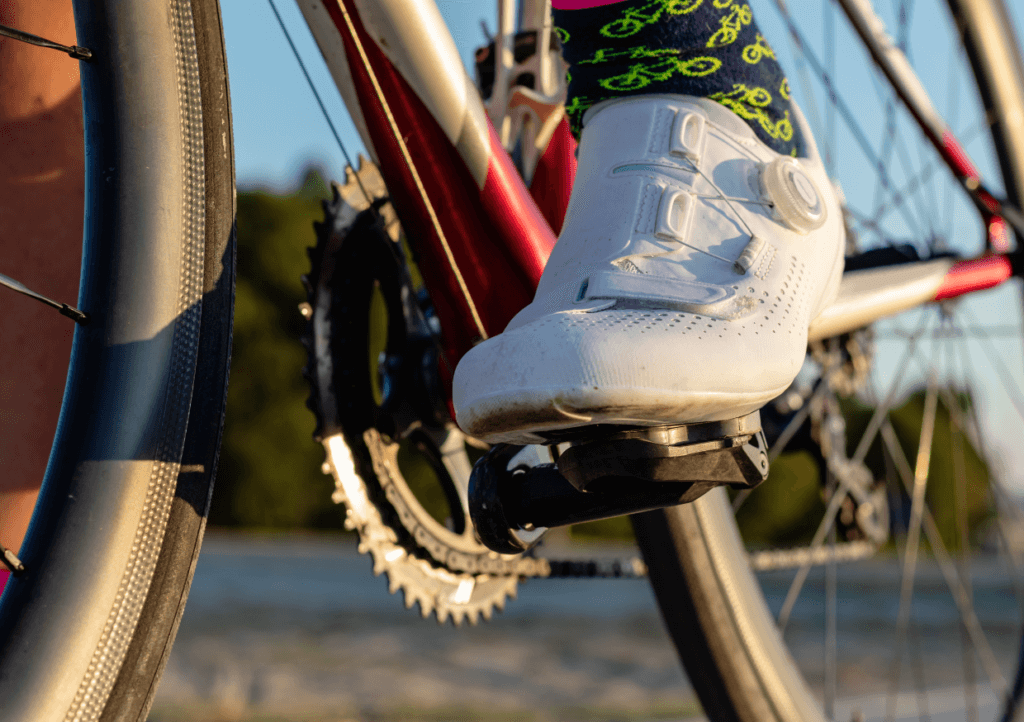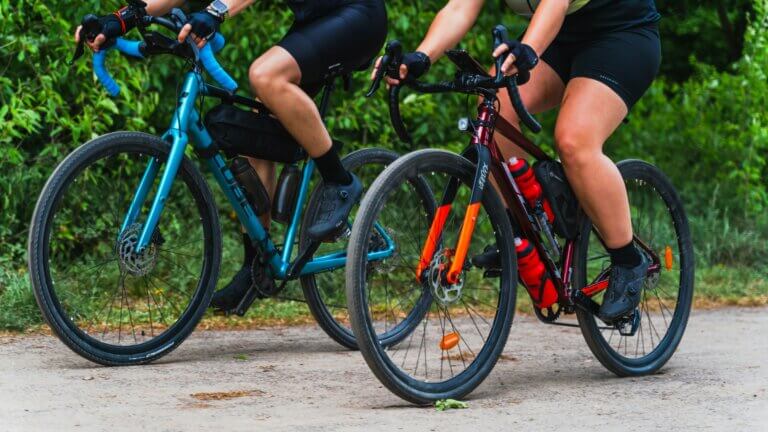Are you tired of your feet feeling like blocks of ice or pins and needles after a long ride? You’re not alone. Numb feet when cycling is a common problem that many cyclists face.
Thankfully there are simple steps you can take to keep those toes tingling with sensation throughout your journey.
In this guide, we’ll explain the causes of numb feet when cycling and provide practical tips to prevent them, ensuring you can pedal comfortably for miles on end.
Why Do I Get Numb Feet When Cycling?

Ever wondered why your feet feel like they’ve fallen asleep during a long bike ride? Well, there are a couple of simple reasons behind this uncomfortable sensation: nerve compression and blood circulation restriction.
Nerve compression occurs when certain nerves in your feet are squeezed or pinched, disrupting the normal flow of signals between your brain and your extremities.
This can happen due to a variety of factors, such as improper cleat placement, lack of arch support, overly tight shoes, or even incorrect pedal stance width. When your riding posture is out of whack, it can also contribute to foot pain or numbness.
The delicate structure of the forefoot makes it particularly vulnerable to compression-related numbness. As you pedal away, not only does the bottom of your foot bear the brunt of the pressure from pressing down on the pedals, but your shoes also add to the squeeze on your feet.
One common spot for foot numbness is the outside of the foot, which is supplied by the sural nerve. If your cleats aren’t positioned correctly or your shoes don’t fit properly, the soft tissues can compress the nerves, disrupting their normal function and causing that dreaded numbness sensation.
It’s less about blood flow and more about a blockage of the peripheral nerves. Once the pressure is relieved, the nerves may start firing off sporadic signals, resulting in that familiar pins-and-needles feeling.
Additionally, cold weather can exacerbate numbness in your feet. When temperatures drop, your extremities, including your feet, are often the first to feel the chill. Combine that with the constant wind chill factor while cycling, and you’ve got a recipe for numbness.
While it’s tempting to soldier on through the numbness, it’s crucial to identify the root cause to prevent any lasting nerve damage. Ignoring the problem could lead to more serious issues down the road.
But fear not, for there are steps you can take to alleviate this discomfort and ensure a more enjoyable ride. Let’s explore those solutions together.
Tips to Avoid Numb Feet When Cycling
Tip 1: Invest in Properly Fitting Shoes

When it comes to preventing numb feet, the right pair of cycling shoes can make all the difference. Many cyclists experience numbness because their shoes are either too small or excessively tight, especially at the start of the ride.
This snugness can restrict blood flow to the nerves, leading to that uncomfortable tingling sensation. It’s essential to find shoes that provide a snug fit without squeezing your feet too tightly.
With the advancements in cycling shoe design and closure systems, finding the perfect fit has never been easier. Look for shoes with multiple points of adjustment that can accommodate variations in foot anatomy.
Additionally, consider using prefabricated insoles or custom orthotics to provide additional support and stability for your feet throughout the pedal stroke.
One crucial tip to remember is to ensure that your closure system is appropriately tightened but not overly tight. This allows your foot tissues to work efficiently without compressing the nerves.
And don’t forget to leave enough room in the toe box for your toes to wiggle comfortably. Pair your shoes with moisture-wicking socks to keep your feet dry and blister-free, ensuring a more pleasant ride from start to finish.
Tip 2: Check Your Cleat Position

Ensuring your cleats are properly positioned is crucial for maintaining foot comfort while cycling. Misaligned cleats can exert undue pressure on specific areas of your feet, leading to discomfort and numbness. To avoid this, it’s essential to check and adjust your cleat position regularly.
The most common cause of numb toes while cycling is poor cleat placement. Ideally, the center of your cleat should align just behind the ball of your foot, providing optimal support and comfort. Some experts recommend positioning the cleat as much as 5mm behind the ball of the foot for maximum comfort.
A forward cleat position, combined with a forceful pedal stroke, can increase pressure under the ball of the foot, where the nerves are most susceptible to compression. This can result in numbness and discomfort during your ride. To alleviate this issue, check your cleat position or, better yet, schedule a professional bike fit with cleat adjustment.
During your ride, pay attention to any sensations of pressure or discomfort under the ball of your foot. If you notice any, consider moving your cleat position slightly rearward to relieve pressure in the forefoot area. This simple adjustment can make a significant difference in your overall foot comfort and help prevent numbness while cycling.
By taking the time to optimize your cleat position, you can ensure a more comfortable and enjoyable riding experience, allowing you to pedal with ease and confidence mile after mile.
Tip 3: Get a Professional Bike Fit

Investing in a professional bike fit is one of the best decisions you can make to prevent numb feet when cycling. A bike fit specialist can assess your riding position, cleat placement, and overall bike setup to ensure optimal comfort and performance.
During a bike fit session, the specialist will take various measurements and assess your riding style to tailor your bike setup to your unique anatomy and preferences. This includes adjusting saddle height, saddle fore-aft position, handlebar reach, and, importantly, cleat position.
A common cause of numb feet is an improper bike setup that puts unnecessary strain on your feet and lower body. A professional bike fit can identify and correct these issues, helping to alleviate pressure points and improve blood flow to your feet.
Additionally, a bike fit can also help improve your overall cycling efficiency and reduce the risk of other injuries, such as knee or back pain. With a properly fitted bike, you’ll feel more comfortable and confident on every ride, allowing you to focus on enjoying the journey without the distraction of numbness or discomfort.
So, if you’re experiencing numb feet or any other discomfort while cycling, consider scheduling a professional bike fit. It’s a worthwhile investment that can enhance your riding experience and keep you pedaling strong for miles to come.
Tip 4: Vary Your Foot Position

When it comes to preventing numb feet during your cycling adventures, one effective strategy is to vary your foot position regularly. Continuously keeping your feet in the same position can lead to increased pressure on certain areas, potentially resulting in numbness and discomfort.
By consciously adjusting your foot position throughout your ride, you can alleviate this pressure and maintain better blood flow to all parts of your feet. For instance, try pointing your toes slightly downward for a few minutes, then switch to a more neutral position.
Alternatively, you can gently wiggle your toes or rotate your ankles to loosen up any tension in your feet and lower legs. Some cyclists find relief by shifting their feet side to side on the pedals, distributing pressure more evenly across the sole of the foot.
Another helpful technique is to stand up out of the saddle periodically and stretch your legs. This not only gives your feet a break from pedaling but also allows you to readjust your foot position and relieve any built-up pressure.
Additionally, paying attention to your pedaling cadence and gear selection can also impact foot comfort. Riding at a steady cadence and avoiding excessive force on the pedals can reduce strain on your feet and lower body.
Similarly, selecting an appropriate gear ratio can help maintain a smooth and efficient pedal stroke, minimizing the risk of overexertion and discomfort.
Tip 5: Keep Your Feet Warm in Cold Weather

Cycling in chilly temperatures can pose a challenge when it comes to keeping your feet warm and comfortable. Cold feet not only detract from your overall enjoyment of the ride but can also increase the risk of numbness and discomfort.
Thankfully, with the right gear and techniques, you can ensure your feet stay toasty warm, even on the coldest of rides.
Insulated Cycling Shoes or Shoe Covers: One of the most effective ways to combat cold feet is by investing in insulated cycling shoes or shoe covers. These specialized footwear options are designed to provide extra warmth and protection against the elements. Look for shoes with built-in insulation or add-on shoe covers made from thermal materials to trap heat and block out cold air.
Thermal Socks: Wearing the right socks can make a big difference in keeping your feet warm during winter rides. Opt for thermal cycling socks made from moisture-wicking materials like merino wool or synthetic blends. These socks offer superior insulation and moisture management to keep your feet dry and comfortable in cold conditions. Consider layering thin liner socks underneath for added warmth and insulation.
Toe Warmers or Heat Packs: For extra warmth on particularly frigid days, consider using toe warmers or chemical heat packs inside your cycling shoes. These convenient heat sources provide instant warmth and can last for several hours, keeping your toes cozy even in freezing temperatures. Simply activate the heat packs and place them inside your shoes before heading out on your ride for long-lasting warmth and comfort.
Layering System: In addition to keeping your feet warm, it’s essential to dress appropriately for the rest of your body to maintain overall comfort and warmth on cold rides. Layering is key to regulating body temperature and staying comfortable throughout your ride.
Start with a moisture-wicking base layer to manage sweat, followed by insulating layers to trap heat, and finish with a windproof and water-resistant outer layer to protect against the elements. Don’t forget to cover exposed skin, such as your ankles and lower legs, with thermal leg warmers or cycling tights for added warmth and protection.

